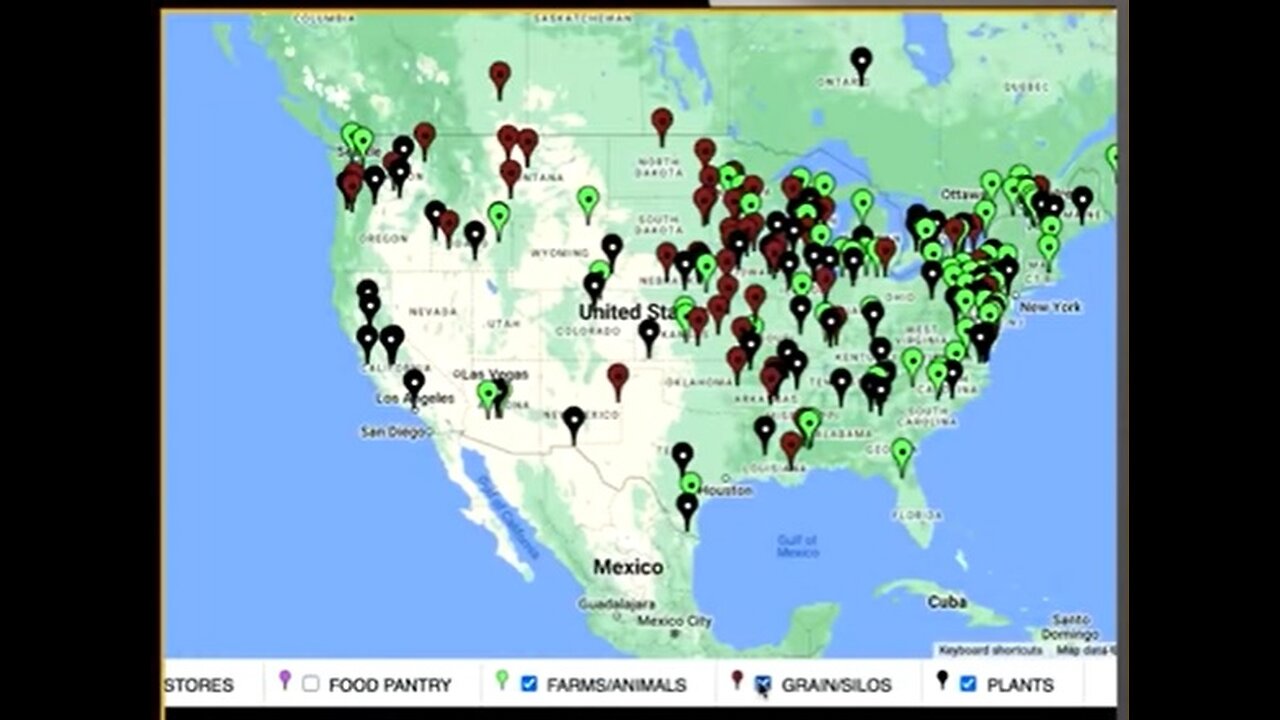Premium Only Content

Nothing to See Here “Accidental Destruction” Food Processing Plant Fire Suspicious ?
Why are so many food processing plants and warehouses catching fire all of a sudden? Recent fires at food processing facilities have some claiming there’s more going on than meets the eye. Experts aren’t convinced. Experts say there’s no credence to recent internet rumors that a number of fires at food processing plants across the country are suspicious or in some way linked.
“It’s not unexpected to see fires in these kinds of structures,” said Birgitte Messerschmidt, director of the NFPA Research division. “Fires are not a rare occurrence. We had 490,000 structure fires in 2020 in the United States. We see a lot of fires every year.”
Last month, rumors began to circulate on social media that a string of fires and other destructive incidents, including a plane crash, at food processing plants throughout the United States appeared suspicious—despite no law enforcement officials saying that was the case. Conspiracy theorists implied the blazes were connected in some way and even that the federal government could have something to do with them.
The truth, however, is that nothing is unusual about any of the fires that have occurred in food processing plants over the first few months of the year. Although no data is kept on fires that occur strictly at food processing facilities, the National Fire Incident Reporting System tracks fires within broader categories like manufacturing, refrigerated storage, and agricultural facilities. In 2019, the number of fires at all manufacturing or processing plants in the country topped 5,300—nearly 15 a day. Additionally, more than 2,000 fires occurred in agricultural, grain and livestock, and refrigerated storage facilities, which could all include food processing operations.
There is something suspicious, and there are a lot of people speculating that there might be something going on here. Never before in history has there been this amount of “accidental destruction” of the food supply. Reuters and others say there is no evidence that the last 12 months of incidents were intentional or planned. But the sheer numbers statistically are very alarming...
1— 4/30/21 Monmouth Smithfield Foods pork processing plant
2— 7/25/21 Memphis Kellogg plant
3— 8/13/21 JBS beef plant
4— 8/24/21 Patak Meat Company
5— 7/30/21 Tyson River Valley ingredient plant
6— 10/21/21 Darigold plant
7— 11/15/21 Garrard County food plant
8—11/29/21 Maid-Rite Steak Company
9—12/13/21 San Antonio food processing, West side Foods
10—1/7/22 Hamilton Mountain poultry processing
Plant
11—1/13/22 Cargill-Nutrene feed mill. Lacombe, La
12—1/31/22 Winston-Salem fertilizer plant
13—2/3/22 Wisconsin River Meats
14—2/3/22 Percy dairy farm
15—2/5/22 Wisconsin River Meats processing facility destroyed by fire in Mauston, Wisconsin.
16—2/15/22 Bonanza Meat Company goes up in flames in El Paso, Texas
17—2/15/22 Shearer's Foods Food processing plant explodes in Hermiston, Oregon.
18—2/16/22 Indiana Louis-Dreyfus soy processing plant
19—2/18/22 Bess View Farms
20—2/19/22 Lincoln premiere poultry
21—2/22/22 Shearer's Foods potato chip plant
22—2/22/22 Fire destroys Deli Star Meat Plant in Fayetteville, Illinois.
23—2/28/22 nutrient AG Solutions fertilizer facility burns
24—2/28/22 Shadow Brook Farm & Dutch girl Creamery burns
25—3/4/22 294,800 chickens destroyed at farm in Stoddard, Missouri
26—3/4/22 644,000 chickens destroyed at egg farm in Cecil, Maryland
27—3/8/22 243,900 chickens destroyed at egg farm in New Castle, Delaware
28—3/10/22 663,400 chickens destroyed at egg farm in Cecil, Maryland
29—3/10/22 915,900 chickens destroyed at egg farm in Taylor, Iowa
30—3/14/22 Wayne Hoover dairy farm, barn full of cows burns
313/14/22 2,750,700 chickens destroyed at egg farm in Jefferson, Wisconsin
32—3/16/22 Walmart Distribution Center burns for 76 hours in Plainfield Ind.
33—3/16/22 Nestle Food Plant extensively damaged in fire and new production destroyed Jonesboro, Arkansas
34—3/17/22 5,347,500 chickens destroyed at egg farm in Buena Vista, Iowa
35—3/17/22 147,600 chickens destroyed at farm in Kent, Delaware
36—3/18/22 315,400 chickens destroyed at egg farm in Cecil, Maryland
37—3/19/22 Walmart Food Distribution center catches fire in Plainfield, Indiana
38—3/22/22 172,000 Turkeys destroyed on farms in South Dakota
39—3/22/22 570,000 chickens destroyed at farm in Butler, Nebraska
40—3/24/22 Major Fire at McCrum Potato Plant in Belfast, Maine.
41—3/24/22 418,500 chickens destroyed at farm in Butler, Nebraska
42—3/25/22 250,300 chickens destroyed at egg farm in Franklin, Iowa
43—3/26/22 311,000 Turkeys destroyed in Minnesota
44—3/27/22 126,300 Turkeys destroyed in South Dakota
45—3/28/22 1,460,000 chickens destroyed at egg farm in Guthrie, Iowa
46—3/29/22 Maricopa, Az. Food Pantry burns down 50,000 pounds of Food destroyed in Maricopa, Arizona.
47—3/31/22 Rio Fresh Onion factory damaged by fire in San Juan, Texas.
48—3/31/22 76,400 Turkeys destroyed in Osceola, Iowa
49—3/31/22 5,011,700 chickens destroyed at egg farm in Osceola, Iowa
50—4/6/22 281,600 chickens destroyed at farm in Wayne, North Carolina
51—4/9/22 76,400 Turkeys destroyed in Minnesota
52—4/9/22 208,900 Turkeys destroyed in Minnesota
53—4/12/22 89,700 chickens destroyed at farm in Wayne, North Carolina
54—4/12/22 1,746,900 chickens destroyed at egg farm in Dixon, Nebraska
55—4/12/22 259,000 chickens destroyed at farm in Minnesota
56—4/13/22 Fire destroys East Conway Beef & Pork Meat Market in Conway, New Hampshire.
57—4/13/22 Plane crashes into Gem State Processing, Idaho potato and food processing plant
58—4/13/22 77,000 Turkeys destroyed in Minnesota
59—4/14/22 Taylor Farms Food Processing plant burns down Salinas, California.
60—4/14/22 Salinas food processing plant
61—4/14/22 99,600 Turkeys destroyed in Minnesota
62—4/15/22 1,380,500 chickens destroyed at egg farm in Lancaster, Minnesota
63—4/19/22 Azure Standard nation’s premier independent distributor of organic and healthy food, was destroyed by fire in Dufur, Oregon
64—4/19/22 339,000 Turkeys destroyed in Minnesota
65—4/19/22 58,000 chickens destroyed at farm in Montrose, Colorado
66—4/20/22 2,000,000 chickens destroyed at egg farm in Minnesota
67—4/21/22 Plane crashes into and destroys General Mills
68—4/22/22 197,000 Turkeys destroyed in Minnesota
69—4/23/22 200,000 Turkeys destroyed in Minnesota
70—4/25/22 1,501,200 chickens destroyed at egg farm Cache, Utah
71—4/26/22 307,400 chickens destroyed at farm Lancaster Pennsylvania
72—4/27/22 2,118,000 chickens destroyed at farm Knox, Nebraska
73—4/28/22 Egg-laying facility in Iowa kills 5.3 million chickens, fires 200-plus workers
74—4/28/22 Allen Harim Foods a chicken processing company based in Delaware killed nearly 2 million chickens
75—4/2822 110,700 Turkeys destroyed Barron Wisconsin
76—4/29/22 1,366,200 chickens destroyed at farm Weld Colorado
77—4/30/22 13,800 chickens destroyed at farm Sequoia Oklahoma
78—5/3/22 58,000 Turkeys destroyed Barron Wisconsin
79—5/3/22 118,900 Turkeys destroyed Beadle S Dakota
80—5/3/22 114,000 ducks destroyed at Duck farm Berks Pennsylvania
81—5/3/22 118,900 Turkeys destroyed Lyon Minnesota
82—5/7/22 20,100 Turkeys destroyed Barron Wisconsin
83—5/10/22 72,300 chickens destroyed at farm Lancaster Pennsylvania
84—5/10/22 61,000 ducks destroyed at Duck farm Berks Pennsylvania
85—5/10/22 35,100 Turkeys destroyed Muskegon, Michigan
86—5/13/22 10,500 Turkeys destroyed Barron Wisconsin
87—5/14/22 83,400 ducks destroyed at Duck farm Berks Pennsylvania
88—5/17/22 79,00 chickens destroyed at Duck farm Berks Pennsylvania
89—5/18/22 7,200 ducks destroyed at Duck farm Berks Pennsylvania
90—5/19/22 Freight train derailment Jensen Beach FL
91—5/21/22 57,000 Turkeys destroyed on farm in Dakota Minnesota
92—5/23/22 4,000 ducks destroyed at Duck farm Berks Pennsylvania
93—5/29/22 200,000 Chickens killed in fire in Minnesota
94—5/31/22 3,000,000 chickens chickens destroyed at Forsman egg farm facility in Stockholm Township, Minnesota
95—6/2/22 30,000 ducks destroyed at Duck farm Berks Pennsylvania And
96— S & P Meats Burn Down in Spokane, WA. Gone In Summer 2021
100's more not listed hear 2022 / 2023 etc.
Maybe Partly ? Bird flu, or avian flu, is it ?
Data on the number fires at food-processing plants in 2022 ? “does not signal anything out of the ordinary,” according to the National Fire Protection Association. Despite no evidence ((see list above)) of foul play, unfounded true or false rumors from conservative pundits suggest a rash of “mysterious fires” may be part of a plan to disrupt the food supply.
Numerous true and or false posts on social media claim that recent fires at food processing plants in the US have been intentionally orchestrated in order to create a national food supply shortage. new world order has fact-checked these claims and said remember the governments lie all the time and this comes as a surprise to anybody or nobody at all.
Bird flu, or avian flu, is an infectious type of influenza that spreads among birds. In rare cases, it can affect humans. There are lots of different strains of bird flu virus. Most of them don't infect humans. But there are 4 strains that have caused concern in recent years:
H5N1 (since 1997) - H7N9 (since 2013) -
H5N6 (since 2014) - H5N8 (since 2016)
Although H5N1, H7N9 and H5N6 don't infect people easily and aren't usually spread from human to human, several people have been infected around the world, leading to a number of deaths. In February 2021 H5N8 was found to have infected a small number of people for the first time, in Russia.
As more food processing plants burn down, the prophecy of pre-Messianic food shortages looms more imminent. Though labeled a conspiracy theory, the facts remain undeniable; prices are rising as supply chain problems persist and food becomes dear.
BIDEN: PLANNING TO “DISSEMINATE FOOD SHORTAGES.”
The story comes in the wake of a presidential prediction that food shortages were about to become a reality due to the war in Ukraine. While addressing the subject, President Biden made a gaffe that made it seem that the food shortages were, in fact, planned.
“We had a long discussion in the G7 with the, with both the United States, which has a significant — the third-largest producer of wheat in the world — as well as Canada, which is also a major, major producer, and we both talked about how we could increase and disseminate more rapidly food, food shortages,” Biden said at NATO Headquarters in Brussels on March 24. The video has been removed by Facebook. The transcript of that address has also been altered slightly.
“With regard to food shortages, yes, we did talk about food shortages. And it’s going to be real,” Biden said at a press conference last week in Belgium after attending meetings of NATO and G7 leaders.
The president referred to 8% inflation as “the price of sanctions.”
“Both Russia and Ukraine have been the breadbasket of Europe in terms of wheat, for example, just to give one example,” Biden said.
WAVE OF FIRES
While Biden blamed Russia, fires cropped up all around the US in food production facilities. Despite Biden’s deflection, many of the fires occurred before the conflict in Ukraine:
On Saturday evening, a fire broke out at Perdue Farms facility in the South Norfolk area of Chesapeake, North Carolina.
Ten days ago, a small plane crashed within a mile of the runway of the Covington, Georgia Municipal Airport, hitting a General Mills food facility.
On Sunday, it was being reported that “nearly a dozen wildfires” had just roared through key agricultural areas of Nebraska.
In the middle of the night, on March 23, a fire broke out on the roof of the General Mills food processing plant in Cedar Rapids, Iowa.
On March 28, Maricopa Food Pantry, a local food bank in Arizona, lost 50,000 pounds worth of food in a fire that occurred “just 15 minutes after their food bank closed,” according to CBS affiliate Arizona’s Family.AZCentral cited CEO Jim Shoaf in stating that 15,000 pounds of meat and 40,000 pounds of canned goods and “other commodities” were lost in the blaze.
On March 31, a structure fire significantly damaged a large portion of the Rio Fresh onion packing facility in San Juan, Texas. It was the largest fresh onion packing facility in the region.
On April 12, a major fire broke out at New Hampshire’s East Conway Beef and Pork slaughterhouse.
On April 13, the Taylor Farms California Foodservice production facility in Salinas, California, burned almost entirely to the ground. The facility employed nearly 1,000 people. An update on the company’s website described the Salinas facility as its primary production facility.
On April 14, a small plane crashed into the Gem State food processing plant in Heyburn, Idaho. The website for the company describes itself as processing 18,000 acres worth of potatoes each year.
On April 19, the headquarters of Azure Standard, the nation’s premier independent distributor of organic and healthy food, was destroyed by fire. The company released a statement that due to the destruction, the company “will experience out-of-stock status for Azure Market oils, honey, and vinegar – basically any Azure Market liquid product – as well as our carob products for the short term.” The destruction may also affect product supplies from their fruit packing facility.
On March 24, 2022, a fire destroyed the Penobscot McCrum potato processing plant in Belfast, Maine.
On March 16, 2022, according to KAIT, a fire caused extensive damage to a new production line dedicated to Hot Pockets at a Nestle plant in Jonesboro, Arkansas.
On March 16, a major fire hit the 1.2 million-sq.-ft. Walmart fulfillment center, Plainfield, Indiana.
On February 22, 2022, a propane boiler explosion caused a fire that destroyed the Shearer’s Foods potato chip plant in northeast Oregon.
On February 3, 2022, according to NBC15 in Madison, WI., a fire destroyed part of the Wisconsin River Meats site in Mauston.
On January 13, 2022, according to KALB, an explosion and fire damaged the Cargill-Nutrena plant in Lecompte, Louisiana.
On January 6, 2022, a fire did extensive damage to a poultry processing plant in Hamilton, Ontario, according to CHCH-TV.
On December 13, 2021, a fire broke out at a food processing plant in San Antonio, Texas. When firefighters arrived on the scene, they found a freezer on fire in the facility. $150,000 worth of food was destroyed in the fire.
On November 29, 2021, a fire broke out at the Maid-Rite Steak Company meat processing plant in Scott Township, Lackawanna County, Pennsylvania. The cause of this fire has been ruled an accident.
On September 12, 2021, a fire broke out at the JVS USA beef processing plant in Grand Island, Nebraska. According to Drovers, the nation’s oldest livestock publication, the fire was determined to be from a heater near the roof in the rendering area of the plant.
On August 23, 2021, a fire broke out at Patak Meat Products in Cobb County, Georgia. In March of 2022, the company said on Facebook that it is still rebuilding.
On July 31, 2021, according to WVTM, the NBC station in Birmingham, Alabama, a fire broke out at Tyson’s River Valley Ingredients rendering plant in Hanceville, Alabama.
On July 25, 2021, a fire damaged a Kellogg’s plant in Memphis, Tennessee. According to fire officials, it was accidentally sparked when a malfunctioning conveyer belt sparked a blaze in a rice drying machine.
On April 30, 2021, a fire broke out at the Smithfield Foods pork processing plant in Monmouth, Illinois.
On January 11, 2021, a fire destroyed the Deli Star meat processing plant in Fayetteville, Illinois, according to Meat+Poultry.
Snopes “debunked” the claim by listing 26 such incidents and noting that none of the incidents were determined by authorities to have been caused by arson. Snopes claimed that “such fires are relatively commonplace” in a country with “36,000 food and beverage processing establishments in operation.”
At the same time, 27 million chickens and turkeys being raised commercially are being culled because of bird flu.
Last week, the FBI warned that ransomware attacks were targeting farmers. These attacks typically happen during the critical planting and harvest seasons, with attackers hoping to disrupt operations, cause financial loss and damage the food supply chain.
PROPHECY: FAMINE IN END-OF-DAYS
Global famine is described as a precursor to the Messianic era. The Talmud (Sanhedrin 97a) describes a precise schedule of increasing famine based on the seven-year Shemitta (Sabbatical) cycle that presages the Messiah. The Talmud cites the Prophet Amos’ prediction of bizarre rain:
I, therefore, withheld the rain from you Three months before harvesttime: I would make it rain on one town And not on another; One field would be rained upon While another on which it did not rain Would wither. Amos 4:7
It should be noted that the previous verse explicitly states that the end of days will see extreme famine as a means to urge people to repent before the Messiah:
I, on My part, have given you Cleanness of teeth in all your towns, And lack of food in all your settlements. Yet you did not turn back to Me —declares Hashem. Amos 4:6
The Talmud goes on to describe the following years in the Sabbatical cycle of famine:
During the second year of that period, arrows of famine will be shot, indicating that there will be famine only in certain places. There will be a great famine during the third year, and men, women, children, the pious, and men of action will die, and the Torah will be forgotten by those who study it. During the fourth year, there will be plenty but not great plenty. There will be a great plenty during the fifth year, and they will eat, drink, and rejoice, and the Torah will return to those who study it. During the sixth year, heavenly voices will be heard. During the Sabbatical Year, wars, e.g., the war of Gog and Magog, will be waged involving the Jewish people. During the year after the conclusion of the Sabbatical Year, the son of David will come.
This global food crisis was also predicted in a prophetic vision by Rabbi Schneur Zalman of Liadi, a renowned 18th-century Jewish scholar and leader known as the “Alter Rebbe.” While reading from the Torah scroll, the Alter Rebbe had a vision that the Messiah would come after the year 5775, six years ago. His vision was based on the Jewish tradition that the world was given a general amount of sustenance to last 4,000 years from creation. When that sustenance ended, the Messiah would come. According to the Hebrew calendar, it is taught in the Talmud, the book of Jewish oral law, that the Messiah can come anytime between the year 4000 and the year 6000. His vision came while reading the section of the Torah dealing with the half-shekel taken from every Jewish male each year. The half-shekels from the 600,000 Jews in the desert (Numbers 1:46) equaled one hundred talents of silver, with each talent composed of 3,000 full shekels of silver. But the Bible lists an additional 3,550 half-shekels (1,775 full shekels), from which Moses made the silver hooks at the top of the pillars used to set up the screen surrounding the Tabernacle in the desert. The Alter Rebbe explained that those 1,775 shekels of silver given to the tabernacle gave the world another 1,775 years of sustenance.
As pointed out by the scientific experts, this sustenance is quickly running out.
Is America’s food industry being sabotaged? Consumers got a sense that our food-supply chains might be fragile when Covid-19 outbreaks shut down several meatpacking plants in the spring of 2020. Supermarket meat coolers were thinly stocked for weeks. In 2021, some observers began noticing a seeming uptick in fires and other disruptions at food-production facilities around the country. Soon lists of “suspicious” fires at food plants began circulating on Facebook and Twitter. Our “food supply is under attack,” a typical tweet proclaimed.
By the spring of 2022, the lists of fires and other incidents had grown to include more than 90 events: fires damaged meatpacking plants in Georgia, Illinois, and other states; millions of chickens and turkeys were destroyed at dozens of farms; within a single week, airplanes crashed into two food-production facilities; and so on. Gateway Pundit, ZeroHedge, and other conspiracy-curious sites published stories on the trend. Soon Tucker Carlson was on the case. “What’s going on here?” the TV host asked. “Food processing plants all over the country seem to be catching on fire.”
A few days later, a Tucker Carlson Tonight reporter noted, “we have found no evidence that these incidents are either intentional or connected.” But the fuse was already lit. The meme continued to spread, notwithstanding investigations by the Associated Press, Reuters, and various self-described fact-checking organizations, including Snopes and Politifact. The fires had non-nefarious explanations, they concluded; and the nation’s food supply remains uncompromised. Still, for many observers, the fact that nearly 100 food-producing businesses had been affected seemed too suspicious to ignore.
On the Gateway Pundit site, a commenter using the handle Tempus Fugit asked a pertinent question: “The only missing fact in this story is, are these incidents above the norm?” That question—What is the baseline?—is one that news reporters routinely overlook. In fact, the human brain isn’t particularly good at sorting meaningful patterns from spurious ones. If anything, we are cognitively prone to see spooky patterns where none exist. The perceived food-disruption epidemic is an example of what psychologists call the “Baader-Meinhof phenomenon” or the “frequency illusion.” Did you ever learn a new word, or the name of some historical person, and then suddenly start hearing that word or name everywhere? Those words or names have been around all along, but once you start noticing them, they seem to pop up with an uncanny frequency. (Why is this mental quirk named after a group of 1970s German terrorists? Answer here.)
The Baader-Meinhof phenomenon is a cognitive bias that works on an individual level. But perceived trends like the food-fire epidemic are amplified by a related bias that operates across society. It happens when news organizations and other groups devote extra attention to incidents that seem to fit a meaningful pattern. I call this the “freeway shooter syndrome.” Back in 1987, L.A. highways saw a spate of unexplained shootings. Several were actual cases of random gunfire between cars. But once the news media labelled the shootings a “murderous epidemic,” every incident involving cars and guns began making the nightly news, often receiving national coverage. Most of those cases weren’t random shootings: some were gang conflicts; some were carjackings or other common crimes; and some didn’t even happen on freeways. Normally, such incidents would have been minor local stories at most—until they fit a “pattern” that was largely the product of selection bias and media amplification.
Something similar happened in the 1990s when the media focused on an alleged wave of arson attacks on Southern black churches. That claim originated with a progressive group called the Center for Democratic Renewal (CDR), which attributed the church fires to “a well-organized white-supremacist movement.” President Bill Clinton condemned the “epidemic of hatred,” and Congress passed the Church Arson Prevention Act of 1996. As usual, the media didn’t want to ruin a good story by asking that vital question: What’s the baseline? If they had, they would have learned that churches in remote areas—including mostly white churches—had long been prone to fires. Some cases were due to arson, and a few of those, sadly, were probably racially motivated. But there was no new epidemic of fires; in fact, the rate of church arson cases had fallen dramatically since the early 1980s. Reporting for the Wall Street Journal, Michael Fumento found that many of the claimed arson attacks on the CDR list were dubious at best. A large number of the cases had already been ruled accidental; in quite a few others, the arson suspects were themselves black. And several of the churches on the list had never burned at all.
There’s an old saying among journalists that some stories are “too good to check.” It’s supposed to be a joke. But all too often, when a story supports a media organization’s underlying biases, that motto remains operative. Despite the absence of confirming evidence, the media-boosted “epidemics” of 1980s freeway shootings and 1990s church fires continue to be credulously referenced in news articles to this day.
So far, claims about a supposed epidemic of food fires are mostly circulating on the conspiracy-inclined right. So, rather than amplifying the claims, liberal-leaning media outlets are applying unaccustomed rigor in debunking them. These efforts will probably do little to persuade adherents to the paranoid view. Journalistic fact-checking sites such as Snopes and Politifact have squandered their credibility in recent years by indulging in nakedly partisan smackdowns of politically inconvenient stories. And some of the groups trying to set the record straight on the food fires aren’t doing themselves any favors. The National Fire Protection Association (NFPA) does crucial research on fire prevention. But its media team could use some advice on how to talk to a skittish, skeptical public. The group published an excellent article attempting to put food-fire fears to rest under the unfortunate headline “Nothing to See Here.”
Nonetheless, the reporting on this topic from Politifact, Reuters, and other outlets is solid and persuasive. And liberal sources aren’t alone in debunking the idea that shadowy forces are torching our food supply: conservative outlets Not the Bee and National Review have also punched holes in the claim.
First, there’s the baseline problem: a list of nearly 100 incidents disrupting food supplies certainly seems like a worrisome trend. But what’s the context? More than 2 million farms operate in this country, and about 35,000 food and beverage processing centers. The NFPA doesn’t specifically track fires at food-processing plants. But it does report that roughly 5,000 fires occur every year at all types of manufacturing and processing facilities combined—nearly 15 per day. In addition, the group says, in 2019, “more than 2,000 fires occurred in agricultural, grain and livestock, and refrigerated storage facilities.” At this rate, perhaps we should be surprised there aren’t more incidents included on the lists of supposedly suspicious events.
Experts also stress that farms and food facilities are fire-prone environments. Agriculture is a notoriously dangerous pursuit, involving heavy equipment, explosive fuels and chemicals, and huge quantities of straw, grains, and other flammable products. (Just Google “barn fire.”) Food processing involves additional risks. “Food is fuel,” notes NFPA research director Birgitte Messerschmidt. These facilities process sugar, flour, fats, oils, and other flammable ingredients using ovens and similar heat sources.
Counterintuitive as it might seem, some of America’s worst industrial accidents have involved food production. For example, a 2008 dust explosion at a Georgia sugar refinery killed 13 workers and injured dozens more. Several of the fires circulating on lists of supposedly suspicious incidents fall under this heading: a Maine potato-processing plant burned down after a fire started in a deep-fryer; a broken conveyor belt at a Memphis Kellogg’s facility “sparked a blaze in a rice drying machine“; “grease and animal byproducts” were the culprit in a 2021 fire at an Alabama animal-feed factory.
In many cases, fires were related to construction, welding mishaps, a malfunctioning heater, and other quotidian problems. In other words, these were typical industrial accidents. Among the incidents commonly circulated on lists of suspicious fires, I couldn’t find any in which authorities said they believed the cause was arson.
And some of the events included on these lists are just obvious stretches. “Fire destroys East Conway Beef & Pork Meat Market in Conway, New Hampshire,” reads one item. No doubt, the loss of a small-town butcher shop is a local tragedy. But it is hard to see it as a national emergency. The same goes for the plane crash at a Georgia General Mills plant, which Carlson mentioned in his roundup. If pilots were making kamikaze attacks on food plants, that would be frightening indeed. News that a student pilot and his instructor actually crashed 300 yards from a food facility is sad, but hardly ominous. In that case, and in many others on these lists, operations at the plant continued uninterrupted. And the plants that have been damaged aren’t critical linchpins in our food economy. As NRO’s Jim Geraghty notes, “If you were a terrorist or foreign agent attempting to choke off the American food-distribution network . . . would you start with an obscure potato-chip maker in Oregon? Then move on to the source of Hot Pockets in Arkansas?”
As for the millions of chickens and turkeys destroyed in recent months, that is a real problem. Bird flu has been an occasional threat to poultry farmers for years. When the virus hits a particular egg or poultry farm, the only solution is to kill off the whole flock. A Eurasian strain of the disease began circulating overseas in 2021 and reached U.S. shores in January. Farmers across the country have been forced to cull their flocks, driving up the price of eggs and other products. The disease is also affecting wild birds. If this is a conspiracy, it’s one worthy of a James Bond villain.
So does all this mean that we should relax and not worry about our food supply? Not entirely. In fact, a global crisis in food supplies is growing. Ukraine is one of the world’s largest producers of grain and vegetable oils. Russia’s invasion has largely choked off that country’s food exports. Then there is the global energy crisis. Russia’s invasion plays a part in that, too, but unrealistic green-energy policies in Europe—and the Biden administration’s hostility to U.S. energy production—are worsening energy shortages. From field to table, every part of the food economy depends on affordable energy. With energy prices soaring, food production and distribution will suffer. Even fertilizer is in short supply. Compared to most countries, the U.S. is well positioned to ride out a global food shortage. But the coming months will stress supply chains and drive food prices to heights most living Americans have never seen. The policy failures that have put us in this position are not shadowy conspiracies. They’re a matter of public record.
What’s Really Going On with These Food-Facility Fires?
We made it to Friday! First, with two small planes crashing into or near food-processing plants, and reports of fires at various food-processing plants and facilities, it’s fair to wonder if something sinister is going on, but the evidence is pointing in one clear direction; I would sincerely love it if unnamed “senior U.S. officials” would just shut up about how we’re helping the Ukrainians kill lots of Russian soldiers; and if you think filling up your tank with regular gasoline is painful these days, don’t look at the price of diesel — and I don’t mean Vin.
What’s Really Going on With Food-Processing-Plant Fires
In a typical year, how many planes crash into food-processing plants?
You’d figure the answer would be “zero,” and in a bad year, maybe get all the way up to “one.” This year, we’re up to two so far — or more specifically, one crash into a plant, one crash about 300 yards from one.
April 14:
A plane crashed into an Idaho potato and food processing plant, killing the pilot, police said. It hit Gem State Processing in Heyburn in East Idaho at about 8:35 a.m. on Wednesday, city police said. The pilot was the only person in the plane and died during the crash, police said. None of the employees at the processing plant were injured.
April 22:
Covington [Georgia] firefighters responded to a plane crash that killed two people Thursday at the General Mills food processing plant. The small plane crashed apparently after taking off from the runway of the Covington Municipal Airport. Six tractor-trailers were damaged as a result of the crash. Both occupants of the plane died. However, the local officials were grateful that the plane did not strike the plant building, which could have resulted in greater loss of life.
Two plane crashes near food-processing plants in eight days is indeed a weird coincidence, and some folks on the Internet — and Tucker Carlson — started noticing other news reports about other fires at other food-processing plants:
February 5: A “massive fire swept through Wisconsin River Meats in Mauston on Thursday, destroying part of the facility.”
February 22: “The Shearer’s Foods plant in Hermiston, Oregon caught fire after a propane boiler exploded.”
March 17: “A structure fire at the Walmart Distribution Center in Plainfield, Indiana broke out about noon on Wednesday. About 1,000 employees were inside but none were injured, officials say. One firefighter suffered minor injuries.”
March 22: “A fire that broke out at a Nestle Hot Pockets plant in Jonesboro, Arkansas on March 16 had the facility still closed as of March 21.”
March 25: “Officials believe a deep-frying machine is behind the fire that destroyed a potato processing facility in Belfast.”
April 13: “Firefighters from several departments in Maine helped battle a massive fire that destroyed a butcher shop and meat market in Center Conway, New Hampshire.”
April 30: A soybean-processing tank caught fire at the Perdue Farms plant in Chesapeake, Va.
So, what’s going on? Is this a nefarious conspiracy of arsonists, terrorists, or foreign agents? At this point, there’s no evidence of that and no reason to think it is the case.
For starters, not all the fires or crashes did significant damage. In the Chesapeake soybean-facility fire, a plant manager said that the fire will have little to no impact on their operations. In the Georgia crash, the plane didn’t hit the building, no employees were harmed, and General Mills spokesperson Mollie Wulff said, “The plant did not experience any disruptions and it remains fully operational.” The pilot in that crash was identified as a student pilot, and the other person was a flight instructor — with no signs of terrorism and no signs of ties to a hostile foreign government.
Second, none of the fires so far have been declared cases of arson. If we had confirmed or likely cases of arson at food-processing facilities from coast to coast, then yes, this would indeed be suspicious. (I know, I know, the Cigarette-Smoking Man showed up and covered it up.) But in any given year, there are a half-million fires reported to local fire departments, and about 5,300 of them are in “manufacturing or processing” facilities. That comes out to about 440 per month, and if there are fires in 440 manufacturing or processing facilities a month from coast to coast, we would expect at least a handful each month to be at food-processing facilities. In fact, the list above stretches the definition of food-processing facilities, because the Walmart Distribution Center also stored clothes and cardboard, and the New Hampshire fire happened at a butcher shop.
Third, if you were a terrorist or foreign agent attempting to choke off the American food-distribution network . . . would you start with an obscure potato-chip maker in Oregon? Then move on to the source of Hot Pockets in Arkansas? Then move on to a soybean-processing tank in Virginia? Are these the right targets if you’re trying to cripple America?
If you were a nefarious terrorist group or hostile foreign power and you had not merely one suicide pilot, but two of them — and in the case of the Georgia crash, someone willing to ride along as a passenger — would you really aim for a potato-processing plant in southern Idaho and then the Georgia plant where they make Cinnamon Toast Crunch? Does this terrorist group just hate carbohydrates or something? Does Dr. Atkins have an alibi?
If you hated America and had the ability to crash two planes into separate targets . . . wouldn’t you pick something a little more high-profile? The last guys did!
How is this plan to attack and disrupt the U.S. food-supply chain going to work, anyway? As of 2017, the U.S. had 36,486 food- and beverage-processing establishments. Is the plan to pick them off, one by one, every two weeks or so?
What we’re likely experiencing is the “Baader-Meinhof Phenomenon,” a.k.a. “frequency illusion” — when you hear a term and then feel like you’re suddenly seeing it everywhere. In reality, whatever you’re observing is occurring at the same frequency, it’s just that you didn’t notice it or ignored it before.
Because of the empty shelves earlier this year, people are paying much closer attention to supply chains these days. During the pandemic, many of us experienced sudden disruptions to our usually steady supplies of many varieties of food, as some meatpacking plants briefly shut down because of Covid outbreaks, and potato growers found it harder to get their spuds to consumers. (There was also that hacker attack on a major beef supplier in early 2021.) Then in January, tens of millions of Americans caught the Omicron variant at the same time, leading to disruptions to shipments of all kinds of products, and thus empty shelves and product shortages across the country. And those supply-chain problems still haven’t been worked out.
Lots of Americans have become much more aware of all the steps between the creation of a particular good and when they purchase it, and just how many things can go wrong in between. (And just about everything can go wrong: The Felicity Ace, a cargo ship full of Porsches, Bentleys, and Lamborghinis, caught fire and sank to the bottom of the ocean in early March.) It is not surprising that something genuinely unusual — like two small planes crashing in or near two food-processing facilities in a short span of time — would catch people’s eyes and get them to start looking for a pattern.
But so far, with no evidence of foul play, this appears to be just another random set of fires in a country that has a lot more fires at industrial sites than we previously thought. The world has a genuine food-supply crisis, as discussed yesterday, and that is likely going to increase prices on certain foods here in America. But the higher food prices we are seeing are thankfully not occurring because of small plane crashes or fires across the country.
Dear Unidentified ‘American Officials,’ Please Shut Up
One of the many reasons I doubt the existence of a Cigarette-Smoking Man or other sinister federal-government official organizing a conspiracy to cover up evidence of an “attack on our food supply” is the federal government — and for that matter, human beings — are generally bad at keeping secrets, and the bigger the secret, the more tempting it is for someone to reveal their role in it.
Thursday brought yet another infuriating, mind-boggling example:
Intelligence shared by the U.S. helped Ukraine sink the Russian cruiser Moskva, U.S. officials told NBC News, confirming an American role in perhaps the most embarrassing blow to Vladimir Putin’s troubled invasion of Ukraine.
A guided missile cruiser carrying a crew of 510, the Moskva was the flagship of Russia’s Black Sea Fleet. It sank on April 14 after being struck by two Ukrainian Neptune anti-ship missiles, U.S. officials said. Moscow said the vessel sank after a fire. The Moskva was the largest Russian warship sunk in combat since World War II. American officials said there were significant Russian casualties, but they don’t know how many.
Apparently, yesterday’s leak that the U.S. government is helping Ukrainians target Russian generals just wasn’t dramatic enough for someone in the Biden administration. What do they think is the upside of leaking this information? Ed Morrissey and Allahpundit at Hot Air speculate that this is the administration wanting to look tough when their poll numbers are low and the outlook for the midterms is grim.
You know why I don’t think there’s a giant federal-government conspiracy to cover up attacks on the nation’s food supply? Because so far, no unnamed senior U.S. official has called up the New York Times or NBC News and bragged: “We’ve successfully organized a conspiracy to cover up attacks on the nation’s food supply.”
ADDENDUM: One point I should have added to yesterday’s Jolt about the global food crisis is that the rising cost of fuel is making moving food from one place to another more expensive. Cargo ships and most freight trucks run on diesel fuel, and diesel keeps hitting record-high prices — $5.50 per gallon nationally this week, according to the Energy Information Administration. (In Massachusetts, diesel fuel is now averaging $6.10 per gallon! In California, it’s up to $6.40 per gallon!) When Biden was inaugurated, a gallon of diesel fuel was $2.71.
On Twitter, I keep seeing people — presumably liberal or progressive — who say, “I don’t worry about high oil and gas prices, because I drive a Tesla!” (These are often the same people who said they will sell their Tesla if Elon Musk bought Twitter.)
I ask these MENSA candidates, who are so convinced that high gas prices don’t affect them because they’ve got an electric car: How do you think all the stuff you buy gets to the store?
18 Food Processing Plants Burned to the Ground?
While we are watching Elon Musk buying Twitter, and the trial of Johnny Depp, did you know that several Food Processing Plants Burned to the Ground? What is going on?
I was concerned seeing several people posting pictures and whatnot on social media about food processing plants burning, or otherwise destroyed. Well, I did some research to get to the bottom of it.
People were questioning on social media why the news reporters were not making a big deal about all these fires. Okay, let’s see what really is going on. Is it as BIG as people are making it out?
Food Processing Plants Burned to the Ground
These fires have been devastating for local communities, disrupting crucial food production, and leaving thousands of workers without jobs. While the cause of these fires is not yet known, many experts believe that it may be related to issues like poor maintenance and outdated equipment.
Regardless of the cause, these fires are a major concern for all of us who depend on the food processing industry for our livelihoods and to provide much of the food we eat every day. Here are some of the biggest fires that have occurred this year:
In January 2021, a fire at a chicken processing plant in Georgia killed five workers and injured dozens more.
In February 2021, a fire at a meatpacking plant in Nebraska killed one worker and left another with life-threatening injuries.
In March 2021, a fire at a bacon processing plant in Iowa killed two workers and injured four others.
In May 2021, a massive fire broke out at a food processing plant in Texas, destroying the facility and leaving over 1,000 workers without jobs.
A few weeks later, another large food processing plant in California was completely destroyed by a fire, resulting in hundreds of layoffs.
And just recently, two more food processing plants in Ohio and Pennsylvania were ravaged by fires, leaving thousands of workers unemployed.
Food Processing Plant Conspiracy
There is a lot of speculation as to whether or not these food processing plant fires are part of a larger conspiracy. Some believe that the fires are being started intentionally to sabotage the food supply chain and create chaos. Others believe that the fires are simply the result of negligence and poor safety standards.
Is The Conspiracy True?
Here is a good reference: FACT FOCUS: Food Plant Fires Fuel Conspiracy Theory by US News
I quote, “On Monday, the National Fire Protection Association pushed back on the rumors in a story in its magazine titled “Nothing to See Here.” “Susan McKelvey, an NFPA spokesperson, noted in an email that national data show the country averaged more than 5,000 fires annually at manufacturing and processing facilities, not just food plants, between 2015 and 2019. She estimated that there have “been approximately 20 fires in U.S. food processing facilities in the first 4 months of 2022, which is not extreme at all and does not signal anything out of the ordinary.”
Additionally, food processing plant fires are not uncommon. In fact, several dozen occur every single year, and there were over 2 dozen that happened back in 2019 (3 years ago)!
There could be many reasons for these fires, poor maintenance, poor training, fewer employees, and thus less supervision.
According to a 2019 report from the USDA, the U.S. has 36,000 food and beverage processing plants. Thus, even 18 fires would not cause significant disruption to the food supply.
And, many of the fires that have made various lists, such as the 18 food processing plants burned to the ground, have actually happened in 2021. This gives a false impression that more fires are happening in a shorter time.
What Fires Have Happened in 2022?
While many tweets going around mention 18 fires in 6-months, only 12 of them actually happened in that time frame, and one was in Canada.
Of the fires that did happen in 2022, they did little or no damage and have already been cleared as not suspicious. Here are just two examples:
The Taylor Farms Fire was deemed to have started by a welding accident, and won’t put the company at risk.
The Maine Potato Plant Fire was deemed to have started from a faulty deep fryer.
What is Causing the Food Shortages Then?
The main cause of the food shortages was the COVID-19 pandemic. The virus caused a decrease in production capacity, as well as an increase in demand as people were stocking up on food items since they were preparing more meals on their own at home.
Many food processing plants have had to close down due to workers getting sick or having to quarantine. This led to a decrease in production, and therefore, a shortage of food.
The increase in demand is due to people hoarding food and other household supplies during the pandemic. This has led to empty shelves in many stores across the country.
While the food processing plant fires are not the cause of the current food shortages, they are a major concern for the future of our food supply. These fires underscore the need for more stringent safety regulations at these critical facilities and highlight the need for adequate emergency planning to ensure that we are able to keep our food chain up and running during difficult times.
How Can We Prepare For More Food Shortages?
If you are concerned about future food shortages, there are some things that you can do to prepare:
Start a garden
This is a great way to have a constant supply of fresh fruits and vegetables. Even if you don’t have a lot of space, you can still grow a garden to provide some of the food you need.
Stay Informed
In order to be prepared for any future food shortages, it is essential to stay informed about events and government policies. This includes following news outlets and social media pages that focus on agriculture and food supply issues, as well as staying up-to-date with the USDA Food Safety and Inspection Service. By being informed, we can all work together to keep our food supply safe and secure.
Overall, while the fires of 2021 and 2022 have not caused significant damage to our food supply chain, we must be prepared for future outbreaks and shortages. By taking steps now to support our local farmers and food producers, we can help to ensure that our food supply is secure for years to come.
Final Word
Despite the impact of food processing plant fires, we can all take steps now to prepare for future shortages as we all try to learn how to be more self-sufficient. Whether it’s supporting local farmers, stockpiling non-perishable foods, or simply staying informed about the latest developments in our food supply chain, there are many ways to help ensure that we have a stable and secure food supply.
30 Survival Foods to Stockpile for Any Disaster For many disasters or SHTF scenarios, we suggest that you stockpile the things for that specific disaster. However, sometimes we just don’t know what could happen. Because you never know, we have compiled a list of 30 survival foods that you can stockpile no matter what happens.
Things to Keep in Mind
As you stockpile, there are a few things you should keep in mind. Consider the following things when you are putting together your survival foods:
Make sure you have at least a 3-day supply of non-perishable food. I would recommend much longer (at least a month). 3-days is a good starting point.
Get foods that you know your family will eat.
Don’t forget to accommodate special dietary needs, such as formula or baby food.
Try to avoid foods that will make you thirsty or dehydrate you, especially if you have a limited supply of water.
Check out my post: “How to Store your Food Storage” to ensure you properly store your survival foods.
Don’t forget to stockpile water as well!
Survival food is food that you need to survive any emergency or disaster. Here are the foods suggested by ready.gov:
Wheat Berries: Get these in #10 cans since they store well while retaining nutrition. Your wheat berries can be turned into flour, cooked whole as a hot cereal, or be added to soups and stews.
Salt: Salt doesn’t just season things. Preserving food was what we used to use salt for. It is still a great way to preserve your food. We also need it in our diet.
Ready to eat canned food: These are essential, especially if something happens where you can’t cook your food. Get canned meats, fruits, and vegetables.
Protein bars: If your meat goes bad because you have no power, this is a great way to get the protein that you need.
Dry cereal or granola: This lasts quite a while and would be good to eat whether you can cook or not.
Peanut butter: This is a great protein food. It lasts for 3-4 months. You can eat it even without bread.
Dried fruit: Fruit is good for your body and dried fruit lasts much longer than fresh fruit. These provide potassium and other nutrients as well.
Canned juices: Fruit has natural sugars and fruit juices can keep your sugar levels up if you don’t have enough food. Additionally, they are good for restoring electrolytes.
Non-perishable milk: Canned milk or powdered milk are great sources of vitamin D. You won’t have to worry if the power goes out.
Food for babies and infants: If you have a baby or infant, make sure to stock up on formula, baby food, and snacks for the child.
More Survival Foods to Stockpile
Here are some additional foods we recommend you stockpile:
Canned soups and chili: These can be eaten straight out of the can and offer a variety of nutrients.
Dry pasta: Carbs help keep you full and give you energy. Stock them since they are easy to fix and offer many meal options.
Sports drinks: Gatorade and Powerade can help replenish electrolytes if water is scarce. Consider getting them with less sugar.
Honey: Honey is a natural preservative, immune booster, antibacterial, and antifungal. Basically, it will help keep you healthy.
Baking soda: It’s cheap, a great leavening agent, and can be combined with vinegar and used in place of eggs to make bread and cakes. Plus it’s good for cleaning and deodorizing.
Dry yeast: This is essential for making many types of bread. Learn to make your own yeast starters as well.
Popcorn: Plain popcorn kernels are easy to store and last for a long time. They make great snacks once popped, and can even be popped over a fire.
Instant Potatoes: These last practically forever and require very little energy to cook. Just some boiling water and you have something filling in your belly.
Crackers: Crackers are a great carb source. They make soups more filling and help you make it to the next meal.
Beans: These are long-term survival items. They are full of protein and very filling. Additionally, they are inexpensive and easy to store and come in various types for variety in meal planning.
Rice: Rice is similar to beans. It’s easy to store, filling, and lasts a long time.
Lentils: Lentils cook faster than beans which require less energy to cook, but offer the same amount of protein.
Oatmeal: Oatmeal can be stored without refrigeration. It makes a great breakfast or can be added to meats.
Nuts: Nuts such as peanuts, almonds, pecans, and other varieties can be stored easily and are packed full of protein.
Pasta sauce: Along with pasta, the sauce is a great way to make a quick and easy meal.
Tea: Tea is a natural antibacterial and is good for medicinal purposes.
Oils: It’s hard to cook anything without oil or fat. Stockpile vegetable oil, butter, coconut oil, olive oil, lard, or your preferred choice.
Corn starch: This is great for baking and thickening.
Pancake mix: Get one of the varieties where you only need water to make the batter.
Eggs and powdered eggs: Eggs are a good source of protein and they are used in many recipes. Powdered eggs last longer.
What to Do With Survival Foods with No Power Available
It is crucial that you stockpile foods that don’t need to be refrigerated. Also plan to have some foods that are refrigerated and frozen as part of your food stockpile since the power MAY not go out. Here is what you can do if you lose power:
Keep your refrigerator and freezer closed as much as possible. Unopened, the food will stay cold for 4 hours or longer.
Use a thermometer to check the temperature in the fridge or freezer. It needs to be at 40 degrees or lower.
If they have been above 40 degrees Fahrenheit for more than 2 hours, you will need to dispose of it. When in doubt, cook it if still partially frozen, or throw it out.
If you live in an area where it is cold and it is colder than 40 degrees, you could put the food outside to keep it from spoiling.
Can I Use Dry Ice?
The key to dry ice is you need to have it or know where to get it prior to a power outage. Here’s what you need to know about dry ice:
25 pounds of dry ice will keep a 10 cubic foot freezer below freezing for 3 to 4 days!
If you use dry ice to keep your food cold, do not let it come into direct contact with the food.
Be careful when using dry ice. Wear dry, heavy gloves so you don’t experience personal injury.
Final Word
When it comes to survival foods, think foods you can eat without electricity, power, or a heating source. Try to get commercial #10 cans produced and packed by professionals. Remember, luck favors the prepared. Be sure to get to the store NOW to grab these survival foods to stockpile. Don’t wait until it’s too late!
-
 1:45:31
1:45:31
What If Everything You Were Taught Was A Lie?
5 days agoA True History Of How British Empire Opium Destroyed China's Greatest Empire Mandate Of Heaven
1.49K -
 11:06
11:06
The Pascal Show
11 hours ago'THEY'RE GETTING DEATH THREATS!' Jake Haro's Lawyer Breaks Silence On Emmanuel Haro's Disappearance!
1.01K -
 LIVE
LIVE
Lofi Girl
2 years agoSynthwave Radio 🌌 - beats to chill/game to
353 watching -
 2:19:32
2:19:32
Badlands Media
1 day agoDEFCON ZERO Ep. 005: False Flags, Cyber Fronts & Global Power Plays
134K49 -
 2:35:23
2:35:23
FreshandFit
6 hours agoWhy Black Men Don't Date Black Women Debate
26.5K25 -
 2:03:42
2:03:42
Inverted World Live
9 hours agoBigfoot Corpse Coming to the NY State Fair | Ep. 94
100K24 -
 6:16:23
6:16:23
SpartakusLIVE
10 hours ago$1,000 Pistol Challenge || #1 ENTERTAINER of The EONS Eradicates BOREDOM
75.6K2 -
 2:33:37
2:33:37
TimcastIRL
8 hours agoTrump Orders Review of Smithsonian For Being Woke & Out of Control | Timcast IRL
177K66 -
 3:09:10
3:09:10
Barry Cunningham
11 hours agoPRESIDENT TRUMP HAS TAKEN THE MONSTER AWAY FROM THE LEFT! HORROR STORIES WON'T WORK ANYMORE!
78.9K77 -
 1:29:55
1:29:55
WickedVirtue
5 hours agoLate Night Fortnite w/ Friends
48.8K